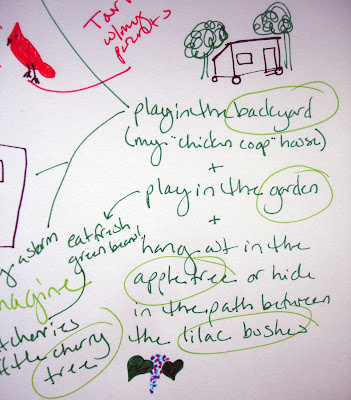In the final week of the Summer Creativity Challenges, we use Aesop’s fable The Ant and the Grasshopper to contemplate the dual nature of our own creative habits. Inside every creative is a Grasshopper, who just wants to play, and an Ant, who plans, worries, and works. In this interpretive challenge, I invite you to explore the fable of The Ant and the Grasshopper and contemplate what ideas and experiences you will take with you from the summer to the fall to fuel your creative endeavors.
It is August, but I am already thinking about September. It comes from small cues: the shortening of the
daylight; the dry rustle of leaves in the driveway.
As I walk home from work, my head filled with future third
quarter work deadlines and thoughts of the encroaching fall semester, I find
myself thinking about The Ant and the
Grasshopper. In this fable, a
live-for-today grasshopper tempts a young ant to put down his work during the
summer and play. The ant is kept in-line
by the other members of his colony. As
the seasons change, the grasshopper finds himself exposed to the elements and starving
from his lack of preparation, while the ants feast on their harvest beneath the
snow.
There is some inconsistency in my memory. I can’t remember what became of the grasshopper
who liked to play. Being a fable with its
moral lessons, I think, it can’t be good.
I have a mind for books, with the ability to retain plot
lines and details about characters. Television
and movies are another matter entirely though, especially anything I watched when
I was little. In my head is a jumble of
impressions from Donald Duck tormenting Chip and Dale to a man in a full bodysuit illustrated with all his internal organs that I saw one morning after Sesame
Street. These images are random, raw and
out-of-context; fragments of things that I think my child-mind was not sure how
to process. My mental images of The Ant and the Grasshopper fall into
this category.
There is something about my incomplete memories of the fable
that does not sit well with me. So I
take my images of a starving grasshopper in a tattered coat tightening his belt
as he walks through the snow; of leaves blowing away on a cold wind; and ants
in little lines rolling fruit into their home in a tree stump to YouTube to do
some research. It is not long before I
find a match in A Walt Disney Silly Symphony entitled “The Grasshopper and the Ants” from 1934. With ants whose facial
features foreshadow Mickey Mouse (sans ears), and a grasshopper who sounds like
Goofy, I know that this is the odd little version of this fable that has lodged
itself in my brain.
Watching the cartoon again brings some resolution. The ants take the grasshopper in from the
cold, and the wise queen ant shows him that his “work” is to play his violin at
their feast. Through the lens of
history, I can see the “Disneyfied” (less grim) interpretation of the fable and
the influence of The Great Depression in this Silly Symphony. For me though, it now makes sense as to why
this fable comes to mind at this time of year.
My inner grasshopper still wants to play, but my inner ant is getting
anxious about deadlines and planning for the busyness of the months to come.
These two parts feel like they are in conflict these
final weeks of summer. In understanding
of the process of creative thinking though, I know they are not. In creating habits to nurture creativity,
such as the exercises in these blog posts, I (and you as a reader) have
actually been working very hard this summer.
In creativity, through play we take risks, incubate ideas, and expose ourselves to new ideas that refill the well. Like the ant in the fable, we’ve stocked up
our thinking supplies, but we did so by letting our inner grasshopper out. In the coming months, I know that my inner
ant will reign supreme (which I am looking forward too) but I hope that just
like the Queen Ant in the cartoon, that she will be kind, generous and
frequently hand the grasshopper his fiddle and ask him to play.
All of this is inspiration for the eighth and final Summer
Creativity Challenge: The Ant and the Grasshopper. This challenge is a great opportunity to
check in and take an hour with your sketchbook and note what ideas and
experiences you’ve generated this summer.
Make a list of how you can use them in upcoming projects, or identify
new projects to take on this fall and winter.
It is also a good challenge in which to meditate about your inner
grasshopper and ant. Do you give them
equal “floor time”? If you become a very
serious Ant in the fall and winter now is a good time to set some goals or plan
some time to let your Grasshopper out.
With this as your touchpoint, plan some time to think about The Ant and
the Grasshopper and consider what the fable means to you as a creative. Record impressions, inspirations, ideas, and
memories in your sketchbook and share here on The Paper Compass.



